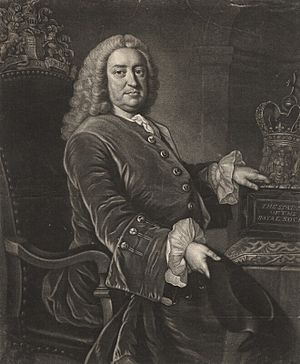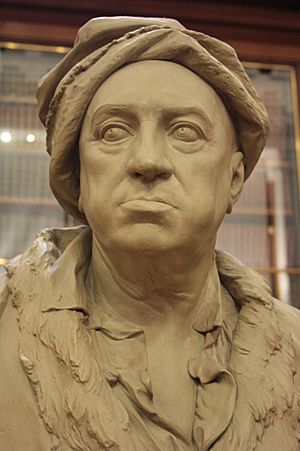Martin Folkes facts for kids
Quick facts for kids
Martin Folkes
|
|
|---|---|
 |
|
| President of the Royal Society | |
| In office 1741–1752 |
|
| Preceded by | Hans Sloane |
| Succeeded by | George Parker |
| Personal details | |
| Born | 29 October 1690 Westminster, London, England, UK |
| Died | 28 June 1754 (aged 63) |
| Spouse | Lucretia Bradshaw (fl.1714–1741) |
| Children | 3 |
| Occupation | Antiquary, numismatist, mathematician and astronomer |

Martin Folkes (born October 29, 1690 – died June 28, 1754) was a very smart English person. He studied many different subjects. He was an expert in old objects (an antiquary) and old coins (a numismatist). He was also a talented mathematician and astronomer. From 1741 to 1752, he was the president of the important Royal Society.
Contents
Early Life and Education
Martin Folkes was born in Westminster, London, on October 29, 1690. He was the oldest son of Martin Folkes, who was a lawyer. Young Martin went to Clare College, Cambridge, a famous university. He was very good at mathematics there. Because he was so skilled, he became a Fellow of the Royal Society when he was only 23 years old. This was a big achievement!
Leading the Royal Society
Martin Folkes continued to be very active in the Royal Society. In 1716, he was chosen to be part of the society's council. Later, in 1723, Sir Isaac Newton, who was the president of the society at the time, made Folkes one of the vice-presidents. After Sir Isaac Newton passed away, Martin Folkes became the president of the Royal Society in 1741. He held this important position until 1752.
In 1742, he was also made a member of the French Royal Academy of Sciences. This showed that his work was recognized internationally. A few years later, in 1746, he received special honorary degrees from both Oxford and Cambridge universities.
Interests and Contributions
Martin Folkes had many interests beyond mathematics and astronomy. He was very interested in history and old things.
Studying Ancient Coins
In 1733, he traveled through Italy. During his trip, he wrote about the weights and values of ancient coins. He also studied famous Roman structures. For example, he wrote about the Trajan and Antonine Pillars in Rome.
English Coinage History
Folkes was especially interested in English coins. In 1736, he presented his "Table of English Gold Coins from the 18th Year of King Edward III" to the Society of Antiquaries. He was also president of this society from 1749 to 1754. In 1745, he published this work along with another one about the history of silver coins. He shared many other papers about Roman history with both the Society of Antiquaries and the Royal Society.
Helping Children
Martin Folkes also cared about helping others. In 1739, he was chosen as one of the founding vice-presidents of the Foundling Hospital in London. This was a charity that helped abandoned children. He stayed in this role until 1747, showing his commitment to helping those in need.
Personal Life
In 1714, Martin Folkes married Lucretia Bradshaw. She was an actress who had performed in famous theaters like the Haymarket and Drury Lane. The famous artist William Hogarth painted a portrait of Martin Folkes.
Legacy
Martin Folkes is remembered for his wide range of knowledge and his leadership in important scientific and historical societies. There is a memorial dedicated to him at Westminster Abbey in London.
See also

